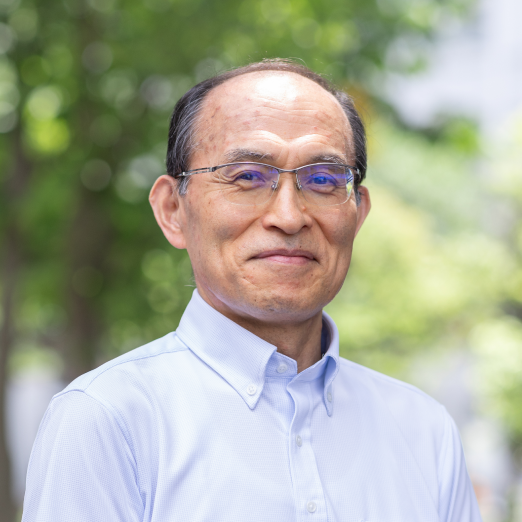
中里 弘道 教授
Hiromichi Nakazato
専門分野
量子力学基礎論,場の量子論
極微の世界の物理法則を探る
研究テーマ
量子論の基礎に関わる諸問題 / 場の量子論
キーワード
量子ダイナミクス,量子開放系,場の量子論,量子化法
LINKS
RESEARCH OVERVIEW
研究概要
原子や原子核、さらにはそれらを構成している素粒子といった極微の世界を支配する力学が量子力学です。こういった極微の世界では私たちの日常とは全く異なる「非日常の世界」が広がっています。皆さんはヤングの干渉実験をご存知ですね。光を二重スリットに通すとスリットの向こうのスクリーン上に明暗の縞が写るという実験です。この事実は光が空間的に広がった波であること示しています。二つの波を重ね合わせると、それぞれの波の山や谷が強め合ったり弱め合ったりします。このことを「干渉」と呼びます。波特有の性質です。二重スリットの実験の場合、二つのスリットそれぞれからやってきた光の波が干渉し、その強弱がスクリーン上に縞となって現れると説明されます。
実は、同じような実験を「電子」に対しても行うことができ干渉縞を見ることができます。電子は波動としての性質を持つのです。その一方で、投入する電子の数が少なければ電子の粒子性を見ることができます。スクリーン上で輝点が現れるのは電子がやってきたところだけで他には現れないからです。しかし、電子を次々に投入すると、スクリーン上に電子がやってきたところ、やってこないところと、はっきりと縞模様が浮かび上がってきます。「干渉縞」つまり波動性の出現です。
大切なことは、その干渉は二つの電子同士の干渉ではないことです。一つの電子を二重スリットに投入した場合、スクリーン上に電子到達の輝点が決して現れないところがあります。そこが多数個の電子を投入した場合に現れる干渉縞の暗い所です。実は片方のスリットをふさいでしまうと、そのような点にも電子はやってきます。つまり干渉縞が現れるためには二つのスリットがあるということが肝要です。
このように電子のような極微の世界の粒子は空間的に広がった波としての性質と空間的に局在した粒子としての性質を兼ね備えていると考えざるを得ないのです。状況によって波になったり粒子になったり...なんとも不可思議な状況です。このような状況を適切に記述しているのが量子論と呼ばれる理論体系で、現代物理学の柱の一つとなっています。実際、これまでのところ量子論に矛盾した実験事実は一つとして報告されていません。
量子力学の創成から半世紀以上が過ぎた20世紀の終わりになってようやく量子力学独自の性質(例えば「重ね合わせの原理」)を直接応用するアイデアが実験室で実現可能になってきました。量子暗号とか量子通信、量子計算などという単語を聞いたことがあるでしょう。量子情報技術と呼ばれる分野の研究です。そこでは、従来は(実現不可能として)無視されてきた事項も真剣に考え直さなければならなくなっています。私たちの研究室では、量子力学に従ってこのような状況の理論的解析を行っています。また、素粒子論で中心的役割を果たす場の量子論、あるいは量子化自体の問題など、幅広く量子論の課題に取り組んでいます。
MESSAGE to STUDENTS
学生へのメッセージ
量子論は現代物理学そして現代の科学技術の基礎となる理論体系です。純粋に学理を追究することが量子計算や量子情報といった分野での開発や応用にもつながるといった意味で大変魅力的な分野です。
学歴・経歴
1985年 早稲田大学大学院物理学応用物理学専攻博士後期課程修了 理学博士
1985年 早稲田大学理工学部助手
1987年 琉球大学理学部物理学科助手
1995年 早稲田大学理工学部物理学科助教授
2000年 早稲田大学理工学部物理学科教授
2007年 早稲田大学先進理工学部教授
所属学協会
- 日本物理学会
- アメリカ物理学会

Hiromichi Nakazato
Professor
Field of study
Quantum mechanics, Quantum field theory
Invitation to a quantum wonderland
Research Themes
Theoretical study of quantum dynamics and its applications
Keywords
Quantum mechanics, Open quantum systems, Quantum field theory, Quantization methods
RESEARCH OVERVIEW
Since its advent almost 100 years ago, quantum theory, which describes behavior in the microscopic world from molecules and atoms down to elementary particles, has solidified its status as one of the most successful theories in modern physics. Although its validity has been confirmed in many fields in physics to an unprecedented degree of precision, quantum theory has been plagued since its birth with certain fundamental issues, which remain unresolved due to the difficulty of achieving experimental counterproof. Recent technological advances have dramatically altered this landscape, allowing the examination of such issues in laboratory experiments. To date, no results that contradict quantum theory have been reported. Moreover, new ideas based on the very fundamental rules of quantum theory (e.g., the superposition principle) have emerged and are being applied in the laboratory in real-world physical systems.
At the same time, these technological innovations have forced major reappraisals of physical processes. For example, an ideal system consisting of an isolated atom cannot in fact exist in the real world. At all times, we must account for the environment, or external agency, including the act of measurement, with which quantum systems are unavoidably implicated. The environment affects dynamics and causes phenomena like dephasing and/or dissipation resulting in loss of quantum coherence (decoherence), a key issue in quantum information and technologies for which the preservation of quantum coherence is crucial. A correct understanding of quantum processes is essential to realizing real-world applications of the ideas proposed in association with such fascinating keywords as quantum computers and quantum cryptography; these applications must be realized as real physical processes in the laboratory, not as mathematical formulas on paper.
Our research explores the dynamics of quantum systems under the influence of the environment, first by treating the whole system composed of the quantum system and its environment as a closed quantum system, then by tracing out the environmental degrees of freedom. The resulting dynamics is no longer unitary and would lead to decoherence in the quantum system. Understanding the associated mechanisms and finding possible ways to avoid decoherence are key issues related to the primary subjects of our current research. These issues have deep connections to profound and interesting questions, including where or how the border between quantum and classical worlds can be defined and when classical rules predominate over quantum rules. These questions also fall within the scope of our research efforts, and we study the transitions between different theoretical frameworks (e.g., classical or quantum, particle or field), seeking a deeper understanding of the meaning of quantization or devising novel methods of quantization.
MESSAGE to STUDENTS
Quantum theory is the theoretical framework on which modern physics and technology are based. The academic study here can lead to developments and applications in the field of quantum computation/information, which can be considered very fascinating.
Education and Career
1985 Doctor of Science, Major in Physics and Applied Physics, Waseda University
1985 Assistant, Department of Physics, Faculty of Science and Engineering, Waseda University
1987 Assistant, Department of Physics, Faculty of Science, University of the Ryukyus
1995 Assistant Professor, Department of Physics, Faculty of Science and Engineering, Waseda University
2000 Professor, Department of Physics, Faculty of Science and Engineering, Waseda University
2007 Professor, Department of Physics, School of Advanced Science and Engineering, Waseda University
Professional Memberships
- The Physical Society of Japan
- American Physical Society
